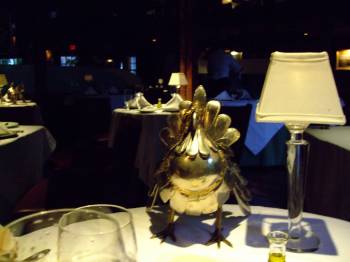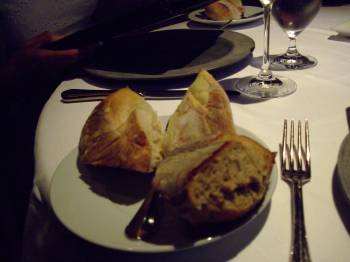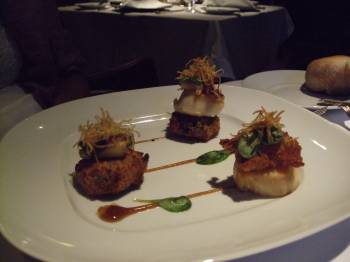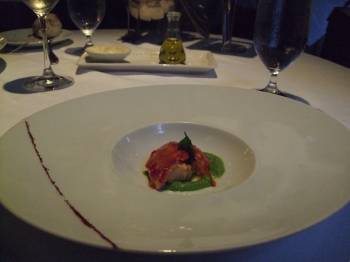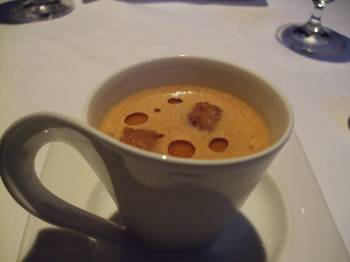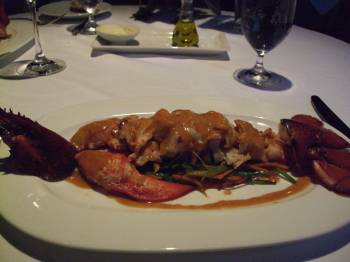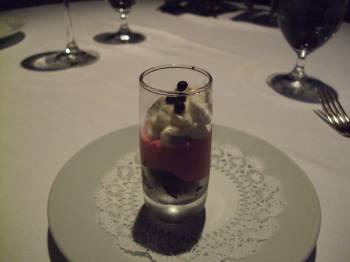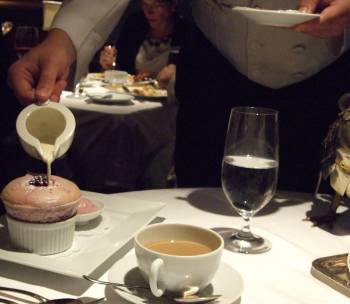When I first dined at White Barn Inn in June of 2012, I wasn’t too impressed. My brother and I ordered the tasting menu and I only really enjoyed about half of the offerings. Since then, the restaurant has done a complete about-face—it’s now my favorite restaurant in Maine and I’ve had four meals there over the past year. The lobster with cognac coral butter sauce is my favorite main dish anywhere and to my mind there is no more enjoyable dining room in which to spend an evening. White Barn Inn was, therefore, the logical destination for my final restaurant meal in Maine before heading off to Bloomington.[1]
With such a dramatic shift in attitude toward the place, it stands to reason that White Barn Inn has really forced me to reevaluate some of my preconceived notions about what makes an enjoyable dining experience. Where I had previously believed that the most satisfying restaurants were those that could execute an extended tasting menu, White Barn Inn has led me to value well-executed prix-fixe meals. I also held a bias against restaurants that are slow to change their menu, but I now realize that it’s these restaurants that allow one to develop a relationship with an established favorite like the lobster. That White Barn Inn performs better in prix fixe than degustation does signify that the restaurant is not without flaw, but no restaurant is perfect. It’s also true that depending on the number of menus offered, the same restaurant offers many different possible experiences, and one of the great pleasures of dining (for me) is arriving at the most satisfying format. Having locked into the prix fixe, I now look forward to the interplay between familiarity and novelty that comes with every meal at White Barn Inn.
My mother and I were seated at my usual table (White Barn Inn tracks its diners.) Not only do I love sitting in the same corner spot, but reinhabiting it creates the (admittedly false, yet delightful) feeling that I own a particular subsection of the space. Obviously, the dining room didn’t look too different, but the artwork changes with the season and so we enjoyed looking at the summertime paintings.
We were greeted with some fowl kitsch. I love that White Barn Inn uses these campy table settings. They mediate the gravity of the dining room and also foreground an element of the ridiculous that one doesn’t often see in ultra-fine dining restaurants.
One change was that our usual server, Andrew, is no longer with the restaurant. Having received his sommelier certificate, he was promoted to maitre’d at Muse, Chef Jonathan Cartwright’s Newport, Rhode Island venture. I did recognize our new server from past meals and service was up to the usual high standard.
Obviously, we had already made up our mind to order the prix fixe, and I also wanted to load as many lobster dishes as possible. White Barn Inn really excels at lobster, in the process exposing just how weak the other fine dining restaurants in Maine are with the crustacean. There may be no region of the country that is so closely tied to a single ingredient, and I think other high-end Maine restaurants get self-conscious about this and try and show that they aren’t reliant on lobster. Unfortunately, this means that a prized ingredient gets left out, so I always look to maximize my lobster when I make it to White Barn Inn. I chose the lobster spring roll, lobster bisque, steamed lobster, and cherry pie soufflé for my four courses. My mom ordered scallops, lobster bisque, steamed lobster, and blackberry soufflé. We both tacked on the smoked lobster from the tasting menu as a supplement.
The amuse bouche was a tiny lamb burger—this was outstanding and a great example of the restaurant’s whimsical character and the little surprises that keep White Barn Inn from growing stale.
There were five bread offerings, but I limited myself to three for the meal.
The picture below makes the spring roll look smaller than it actually was; it is a signature of the restaurant and includes snow peas and carrots. An outstanding preparation that demonstrates why restaurants are justified in keeping established dishes on the menu.
My mom went with a playful scallop trio; the fried items were squid ink arancini. I couldn’t try this course because of my scallop allergy but my mother gave it her endorsement.
Our smoked lobster arrived next; this was ordered as a supplement but comped on our bill. The meat was first butter poached and then smoked; butter poaching is my favorite way to enjoy lobster as the texture is most delicate, but smoking it adds an uncanny dimension that one won’t find anywhere else. An English pea puree complemented the lobster. Depending on my mood, I would take this course over the steamed lobster that I ordered for my main dish.
Our lobster bisque was served as an intermezzo leading us into the main course. The broth was enhanced by lobster croutons (basically, tiny lobster fritters.) This small dish was good but a letdown after the memorable smoked lobster—an example of how a really outstanding course will sometimes lead to diminished returns on the next dish.
The steamed lobster with cognac coral butter sauce has been on the menu for many years. Meat from a whole lobster is supplemented with housemade fettucine, shaved carrots, and snow peas. This rendition was as outstanding as I remembered. With any course this large, the question of portion size comes into play; serving an entire lobster’s worth of meat is in excess of what’s necessary, but when everything tastes so outstanding, the pleasure is only enhanced with the grand scale. Larger portion is maybe the biggest advantage of the prix-fixe menu, as one can really lock into a great plate of food and repeat delicious flavors over many bites.
Our pre-dessert was a blueberry parfait—very nice and a necessary transition from the drama of the lobster dishes.
My mom was very pleased with her blackberry soufflé. A mascarpone sauce was poured tableside and the strong summer berry flavor came through nicely.
My cherry pie soufflé was the only lowlight; it was described as having schnapps liquor, but I couldn’t taste any and so the dessert lacked oomph. Based on the blackberry soufflé, it’s clear that the pastry program can cook a great soufflé, but this one needed work and I’m not surprised to see that it’s no longer on the menu.
A familiar collection of excellent mignardises closed our meal. We were also served financiers, but I forgot to snap a photo of them.
***
It would be easy to criticize Cartwright for remaining so unchanging, but his cuisine is distanced from the present without feeling dated in any way. Roughly two weeks after this meal, I dined at Grace, and there was a palpable contrast between Cartwright’s timeless fare and Curtis Duffy’s cuisine, which of course is very much borne out of the present moment. I’m not sure one chef is ‘better’ than the other, but I enjoyed the food from this meal much more. It is probably true that Duffy is more ambitious, but Cartwright has established his signature dishes and I wouldn’t want to see them disappear.
Restaurants are typically reviewed on the basis of one or two meal samples, and I think White Barn Inn exposes the limitations of this approach. There are restaurants that deliver a great impression on a 1-2 meal sample but whose impact is diluted over the long run, and other restaurants—like White Barn Inn—that don’t necessarily overwhelm at first but reward repeat visits through repeatable execution and classic dishes. Whenever one dines at a restaurant four times in one year, the newness begins to wear off, but I think it’s also true that one begins to cultivate a relationship with the restaurant; a temporal dimension comes into play, as the restaurant becomes less as an object to be analyzed in a single review and more a living entity that becomes part of one’s past, present, and future.
[1] This review does not add much to my previous posts on White Barn Inn and is intended to work in concert with the earlier write-ups to form an archive of sorts.


